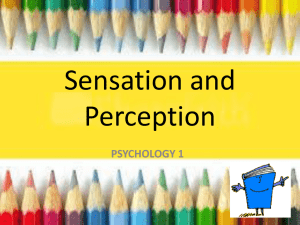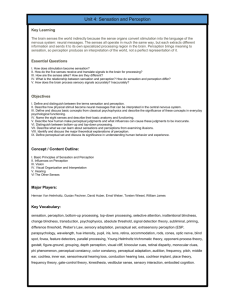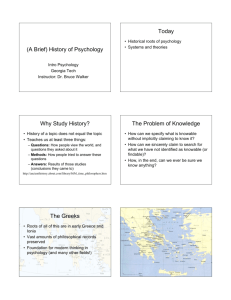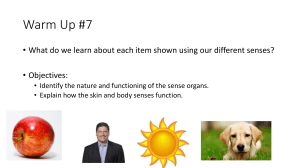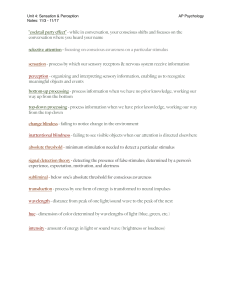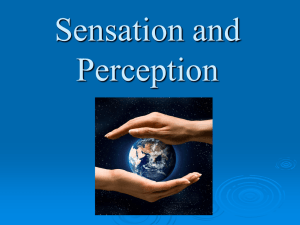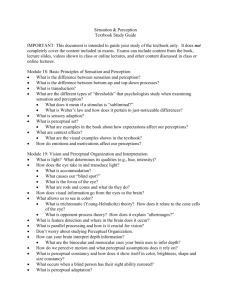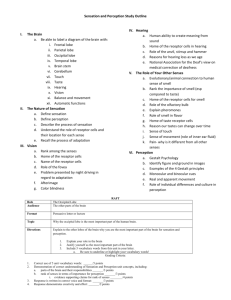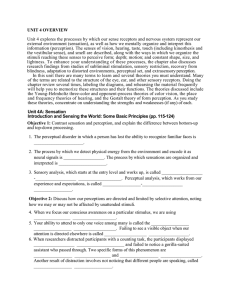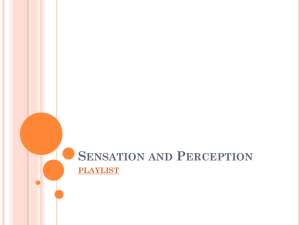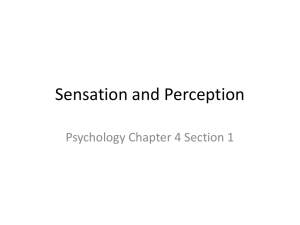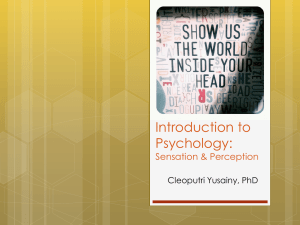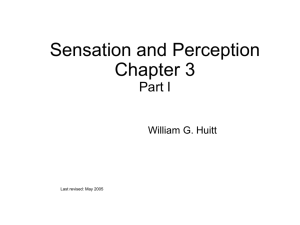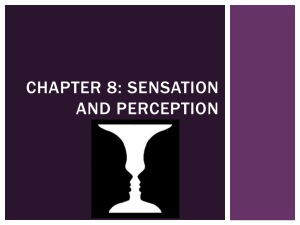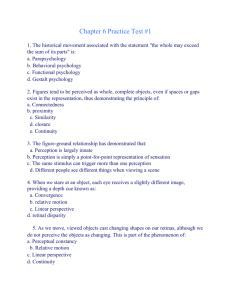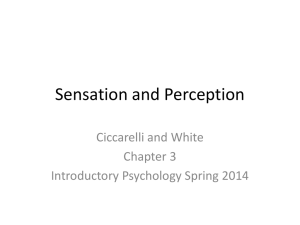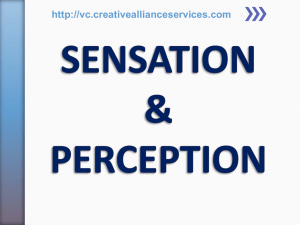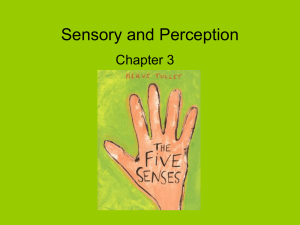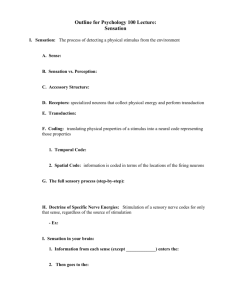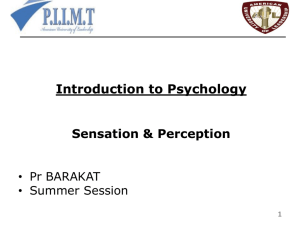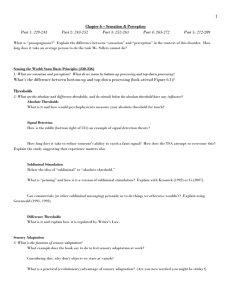Chapter 8
advertisement
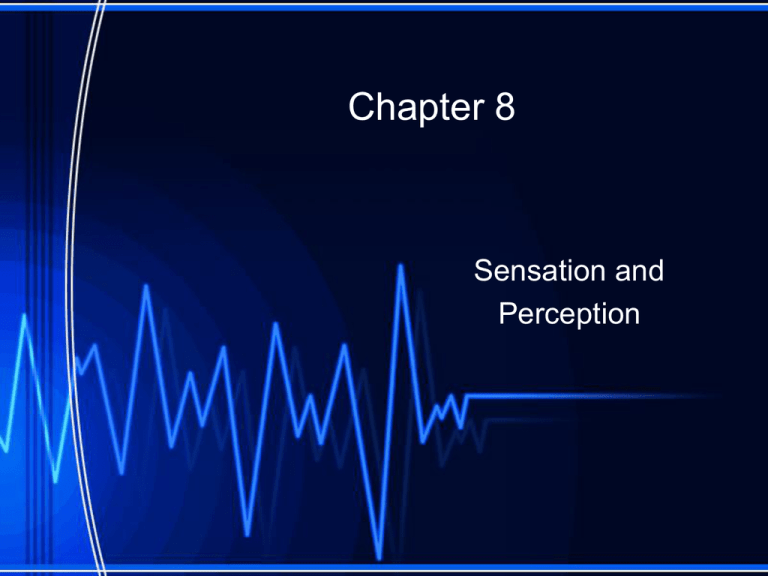
Chapter 8 Sensation and Perception Section 1: Sensation • Sensation and perception are needed to gather and interpret information in our surroundings. • Any aspect of or change in the environment to which an organism responds is called a stimulus. – A sensation occurs anytime a stimulus activates one of your receptors. – The sense organs detect physical changes in energy such as heat, light, sound, and physical pressure. • A sensation may be combined with other sensations and your past experience to yield a perception. • Psychologists are interested in the relationship between physical stimuli and sensory experiences. – This study is called psychophysics. – The goal is to understand how stimuli from the world affect the sensory experiences. • In order to establish laws about how people sense the external world, psychologists first try to determine how much of a stimulus is necessary for a person to sense it at all. This is called the threshold. – Absolute threshold: the weakest amount of a stimulus required to produce a sensation. • In humans, the absolute threshold in the five senses are: – Vision: seeing a candle flame 30 miles away on a clear night – Hearing: hearing a watch ticking 20 feet away – Taste: tasting 1 teaspoon of sugar dissolved in 2 gallons of water – Smell: smelling I drop of perfume in a 3 room house – Touch: feeling a bee’s wing falling a distance of 1 centimeter onto your cheek ** Humans sense a somewhat limited range of the physical phenomena in the everyday world. • Weber’s Law: the larger or stronger a stimulus, the larger the change required for a person to notice that anything has happened. – Backpack example • Senses are most responsive to increases and decreases, and to new events rather than to ongoing, unchanging stimulation. – Movie theater example Section 2: The Senses • Vision – Is the most studied of all the senses – Provides us with a great deal of information about our environment – It works by: • Light entering the eye through the pupil where it reaches the lens that focuses the light onto the retina • The photoreceptor cells (rods and cones) change the light energy into impulses that travel to the brain by way of the optic nerve – When a person’s cones do not work properly, he/she is said to be color-deficient (color blind) – Binocular vision • Because we have two eyes, we see two images that combine to produce one complete image (binocular fusion) • Difference between the images is called retinal disparity – Essential for depth perception » The greater the difference, the closer the object • Hearing – Depends on the vibrations of the air, called sound waves, which passes through various bones until they reach the inner ear where hair like cells change the sound vibrations into signals that travel to the brain through the auditory nerve – 2 Types of Deafness • Conduction – something hinders the motion through the outer or middle ear or when the bones become rigid and can not carry sounds – can be helped with hearing aids • Sensorineural – damage to the cochlea, hair cells, or the auditory neurons – can be helped with cochlear implants • Smell and Taste – Known as chemical senses because they are sensitive to chemical molecules – Gaseous molecules travel up the nose to the receptors that send messages to the brain through the olfactory nerve – Liquid chemicals stimulate receptors in the taste buds, sending information to the brain • Four primary sensory experiences are sour, salty, sweet, and bitter – The combination of taste, smell, and tactile sensations is known as flavor • Touch (skin senses) – Receptors in the skin provide the brain with at least four kinds of information about the environment : pressure, warmth, cold, and pain – Gate control theory of pain • We can lessen some pains by shifting our attention away from the pain impulses or by sending other signals to compete with the pain signals Section 3: Perception • Perception: brain receives information from the senses and organizes & interprets it into meaningful experiences • The brain makes sense of the world by creating whole structures out of bits and pieces of information – each whole created by the brain is called a Gestalt. – The principles that people use in organizing such patterns are: • Proximity – group together elements that are close together • Continuity – see smooth, continuous contours • Similarity – group together elements that are similar in appearance • Simplicity – perceive a pattern in the simplest form • Closure - group according to enclosed or completed figures • Perceiving is something that people learn to do. • Experiments show that active involvement in one’s environment is important for accurate perception. • Learning to perceive is influenced by our needs, beliefs, and expectations. – “When we want to see something, we are more likely to see it.” • Hungry people experiment • Constancy – When we have learned to perceive certain objects in our environment, we tend to see them in the same way, regardless of changing conditions. • Illusions – Incorrect perceptions created when perceptual cues are distorted so that our brains cannot correctly interpret space, size, and depth cues. • Extrasensory perception (ESP) – Receiving information about the world through channels other than the normal senses – Four types of ESP • 1) clairvoyance – perceiving objects or information without sensory input • 2) telepathy – reading someone else’s mind or transferring one’s thoughts • 3) psychokinesis – moving objects through purely mental effort • 4) precognition – ability to foretell events – Scientists have been investigating ESP since the 1900’s. – Most people claiming to have ESP have been proven to be frauds.
